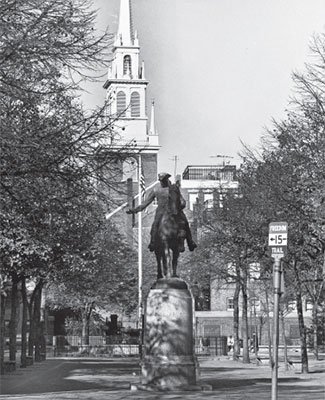
Old North Church, located at 193 Salem Street in Boston’s North End, is where the “one if by land and two if by sea” signal was sent from the church’s wooden steeple. Courtesy of the Boston Public Library, Print Department.
Chapter 7
NORTH END HAUNTS
Based purely on aesthetic, Boston’s North End should be haunted. In fact, horror writer H.P. Lovecraft believed the neighborhood was fertile ground for the supernatural. In Pickman’s Model, the author convincingly wrote about the inexplicable magic of the North End’s spirited underbelly, adding that “the whole North End once had a set of tunnels that kept certain people in touch with each other’s houses, and the burying ground and the sea.” He also talked about the lack of ghosts in Boston’s Back Bay, saying the newly created land around Newbury Street hadn’t been around long enough “to pick up memories and attract local spirits.”
Michael Baker, head of the group called the New England Center for the Advancement of Paranormal Science (NECAPS) and member of Para-Boston, leaves no gravestone unturned when he investigates a so-called haunted location, which includes a few of the old structures in the North End. Baker said he’s heard very few reports of ghosts in the historic buildings surrounding Copp’s Hill Cemetery. Why? He believes it’s a cultural thing.
“The North End seems a bit devoid of claims,” Baker said when asked about the lack of alleged paranormal activity in the historically Italian neighborhood. “I have always felt much of it has to do with the religious views of the people who live there. There are a lot of old-school Italian families there, people who tend to be well embedded in religious culture. I have noticed that this Old World approach to religion often brings with it an unspoken rule about dabbling in or acknowledging things related to the paranormal.”

Old North Church, located at 193 Salem Street in Boston’s North End, is where the “one if by land and two if by sea” signal was sent from the church’s wooden steeple. Courtesy of the Boston Public Library, Print Department.
Baker’s “real science, real answers” mantra cuts through the usual smoke and mirrors associated with the “Boo!” business. With Baker, there’s no over-the-top Ghostbusters gear or fake Cockney accents. When it comes to science-based paranormal investigations, he’s the real deal.
“Basically, there is no ghost-catching device,” explained Baker. “The field has changed. It has taken more of a fun-house approach—it has become a novelty—and it has set the paranormal investigation field back in a way. A lot of people are trying to use a screwdriver to hammer a nail. People go in with preconceived notions, and if anything happens, they’re going to come to a certain conclusion. If something moves [or] bumps or they hear footsteps, they’re going to automatically assume that it’s a ghost, and that’s a bad way to investigate.”
Baker continued: “Technology can’t detect spirits…we have to prove that spirits exist before we can build anything that can measure them. There was a shift in the field, occurring in the ’90s, where it’s a game to mimic what is seen on television. There was a period where it was purely scientific, and now people think they can turn off the lights, pick up an infrared camera and capture a ghost.”
Oddly, one of Boston’s more infamous made-up ghost stories involves a man leaving his home from Middle Street in the North End. William Austin’s Peter Rugg literary character—who stubbornly rode his horse into a thunderstorm in 1770 and was cursed to drive his carriage until the end of time—was completely fabricated. However, people over the years have reportedly spotted the ghostly man with his daughter by his side frantically trying to make the trek back to Boston.
According to the legend, Rugg was visiting Concord with his daughter and stopped by a tavern recommended to him by a longtime friend before heading back to Boston. A violent thunderstorm was heading in their direction and the watering hole’s owner insisted that Rugg and his daughter stay the night. Rugg, a notoriously defiant old man, refused the offer and headed directly into the storm. The horse and its driver never returned to Boston. However, people claim to have seen what was called “the Stormbreeder,” a phantom carriage driven by Rugg and considered to be the precursor to a thunderstorm, all over New England. One man in Connecticut said he had a face-to-face encounter with the ghost. “I have lost the road to Boston. My name is Peter Rugg,” the specter supposedly said before vanishing into thin air.
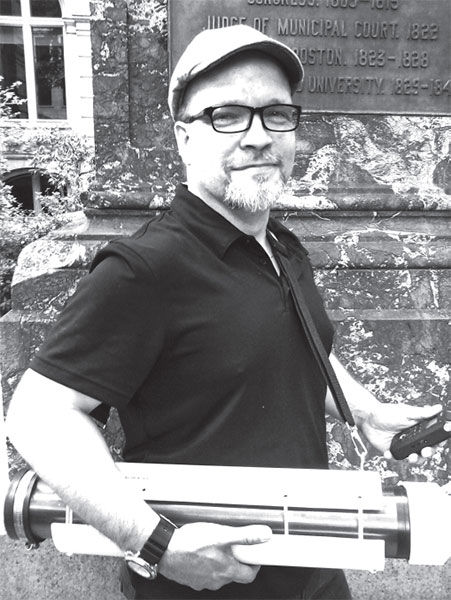
Michael Baker, head of the group called the New England Center for the Advancement of Paranormal Science (NECAPS), investigated several of the locations featured in Haunted Boston Harbor. He shows off his homemade electromagnetic spectrum sensor. No, it’s not a prop from Ghostbusters. Photo by Sam Baltrusis.
For many, the only real ghosts that exist are the ones that haunt the insides of their heads.
“There are some claims in the North End,” continued Baker. “I know there are stories about the tunnels there. I have had a few calls from the North End over the years, but unfortunately, they never amounted to anything significant.”
Baker isn’t ruling out the possibility of ghosts in the North End. However, he hasn’t found anything substantial while investigating there and finds the locals to be unusually tight-lipped. “I know several old Italian families and they won’t even embrace a discussion about ghosts,” he said. “To them it’s religiously forbidden. Of course, this is just my speculation but it’s a pattern I’ve seen in people I speak with.”
While the North End is mysteriously devoid of reported ghost sightings, the legends associated with its series of rumored underground tunnels seem to be based on reported fact. “There definitely were tunnels underneath the North End,” explained Peter Muise, author of Legends and Lore of the North Shore. “For example, in the nineteenth century, construction workers discovered that a house at 453 Commercial Street had an archway in its cellar that connected to a large tunnel. It led from Commercial Street up toward Salem Street. Unfortunately, this house was demolished in 1906 and the tunnel entrance along with it.”
Who built the tunnels? Muise said they were probably built in the 1700s by Thomas Gruchy, a privateer who became wealthy from raiding Spanish ships. “He invested his loot in several Boston businesses, including a distillery, a warehouse and several wharves. His wealth was excessive even for a privateer, and many of his neighbors suspected that he was somehow smuggling goods into Boston without having to pay the British tariffs. Despite his shady background he became a prominent member of Boston society. He purchased the Salem Street mansion of former Governor Phipps in 1745, threw lavish parties, and became a congregant at the Old North Church. Four plaster angels that he looted from a French ship still decorate the church today.”
Gruchy mysteriously disappeared in the 1700s and left behind a legacy of underground tunnels and stolen goods. “At the height of his wealth and popularity Gruchy vanished from Boston and was never seen again,” Muise explained. “It’s believed that he was smuggling goods past the British using a series of underground tunnels, and fled town when they discovered what he was doing. Sadly his mansion on Salem Street was torn down years ago.”
Muise said that many secrets are buried beneath the North End’s bloodstained soil. “A few other North End tunnels have been found,” he said. “A book from 1817 mentions a tunnel under a house on Lynn Street, and a guide to Boston architecture notes that the cellar of a house on Salem Street still has an entrance to a tunnel in its basement. It has been bricked off so it’s not clear where the tunnel goes or what it was used for.”
Perhaps the ghosts of the North End are hiding in these hidden tunnels? Yes, it’s possible that they’re lurking in the shadows beneath the cobblestone streets traveled by thousands of tourists flocking to a neighborhood famous for its old-school Italian eateries and Paul Revere.
COMMERCIAL STREET
Based purely on the bizarre disaster that unfolded on January 15, 1919, the North End’s Commercial Street is ground zero of one of Boston’s more freakish Twilight Zone–style events. On an unusually warm January day, a large vat of molasses heated up and the sugary liquid used in the distillation of rum expanded beyond the capacity of its container. The tank, located at 529 Commercial Street, then burst.
A wave of 2.5 million gallons of molasses raced down the street. It was forty-feet high and moved at thirty-five miles per hour. The dark tide was so powerful that a truck was picked up and hurled into Boston Harbor. Twenty-one people were drowned or crushed in the not-so-sweet Great Molasses Flood, and at least one dozen horses were swallowed up by the deadly goo.
“Molasses, waist deep, covered the street and swirled and bubbled about the wreckage,” reported the Boston Post. “Here and there struggled a form—whether it was animal or human being was impossible to tell. Only an upheaval, a thrashing about in the sticky mass, showed where any life was.…Horses died like so many flies on sticky fly-paper. The more they struggled, the deeper in the mess they were ensnared. Human beings—men and women—suffered likewise.”
More than 150 people suffered from injuries sustained during the disaster. Blocks were flooded. Cleanup crews used a fireboat to wash away the mess. The molasses swept into Boston Harbor and people tracked the sticky goo all over Boston—on the subway, in the streets and on their clothes. “Everything a Bostonian touched was sticky,” reported Smithsonian magazine.
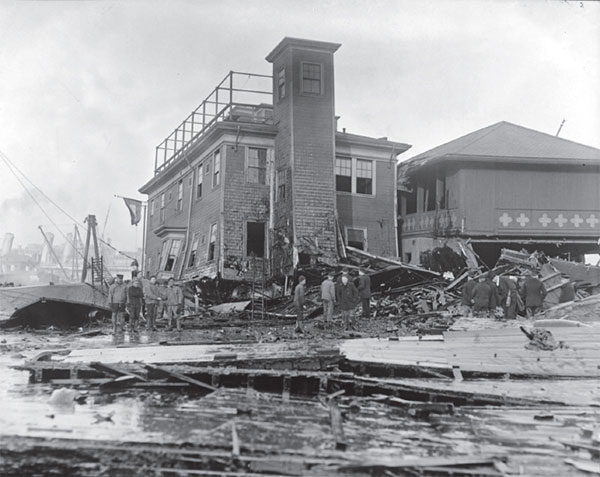
A wave of 2.5 million gallons of molasses raced down the street on January 15, 1919. Twenty-one people were drowned or crushed in the Great Molasses Flood. Courtesy of the Boston Public Library, Print Department.
Ghost lore enthusiasts often ask if the Boston Molasses Flood has left a psychic imprint on Commercial Street. The dark tide may have caused what parapsychologists call an aura of disaster—fertile ground for the birthing of ghosts.
Visitors often report smelling molasses near 529 Commercial Street, even though the tragedy occurred almost one century ago. Sensitives to the paranormal often claim to feel a heaviness near the scene of the event.
Some ghostly activity has also been reported in the area, which may or may not be related.
In 1974, a sighting of a ghost ship near Commercial Wharf was reported. The crew of a local fishing vessel set sail one foggy night. After departing from the nearby Long Wharf, the boat passed near the site of the Great Molasses Flood. Suddenly, a residual haunting from Boston’s past manifested in front of them.
“This was no ordinary ship,” wrote Joseph Mont and Marcia Weaver in Ghosts of Boston. “Before the fishing vessel was a battered, barely seaworthy English frigate that appeared to be at least two centuries old. Not a man was seen on deck and not a soul was on the bridge.”
As soon as the phantom frigate appeared, it vanished.
The fishing vessel was then engulfed in a mysterious fog. Soon after the visual encounter, the sailors picked up mysterious chatter on their radio. “Someone was trying to contact them,” continued Mont and Weaver. “The message, however, consisted of what sounded like a group of men screaming obscenities in a Cockney accent. Whether it was anger or panic is unclear.”
Based on old seafaring superstitions, it’s bad luck to even mention a ghost ship sighting. One man on the small fishing boat did report the event to the Coast Guard. No rational explanation surfaced; it continued to be a Boston Harbor mystery.
Lewis Wharf, which is a stone’s throw from the Great Molasses Disaster site, is home to a former boardinghouse for wayward ship captains and sailors who docked in Boston. Built in 1839, it was known as the Pilot House. Today, the structure’s façade is a coffee shop and bank. Law offices and condos are also located in the building. Behind the structure is a green space, called Pilot House Park, which faces the water and connects to the 46.9-mile path known as the Boston Harborwalk.
According to multiple sources, the spirits of salty sea captains have been seen in the Pilot House. “People who have spent time in the building report hearing unintelligible voices of men permeating the halls,” wrote Christopher Forest in Boston’s Haunted History. “The clink and clatter of glass, with an occasional smash, also have been known to punctuate the night, heralding a rowdy day of old.”
Forest said that a lady in white has been spotted throughout the Pilot House. She appears as a full-bodied apparition and is known to move objects and sometimes even closes doors. In addition to the woman in white, shadow figures have been spotted in the building. It’s common for doors to open and close, as if spirits were trying to enter their rooms in the former overnight haunt.
“Even outside of the wharf, visitors and residents alike have claimed to see or feel something unnatural along the water,” continued Forest. “Sometimes, this presence actually manifests itself in the form of an old sailor or captain wandering the wharf in search of a room at the Pilot House or maybe even a ship to board. Other times, the presence surfaces over the water, floating on the crest of waves appearing as orbs.”
File under: dark water
OLD NORTH CHURCH
What really happened at Old North Church on April 18, 1775? The famous “one if by land, two if by sea” line from Henry Wadsworth Longfellow’s poem “Paul Revere’s Ride” is based on actual events orchestrated by Revere and carried out by Old North Church’s sexton, or the church’s caretaker, Robert Newman. Revere’s friend and the church’s vestryman, Captain John Pulling Jr., was also there to warn the Sons of Liberty that General Thomas Gage and his British troops were coming.
Two lanterns, held that fateful night at the top of Old North Church’s wooden steeple, ignited what would become the beginning of the American Revolution.
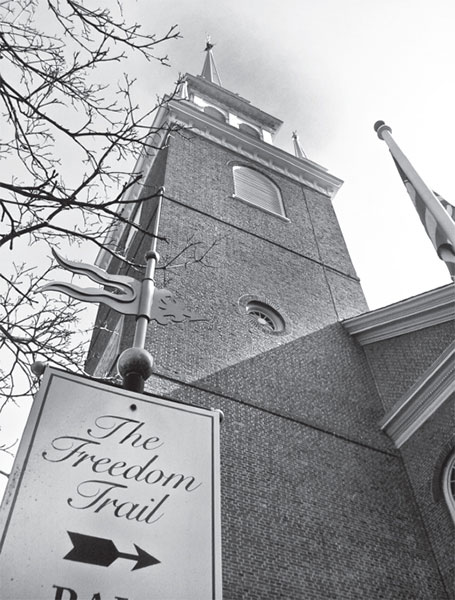
Old North Church’s former sexton had a close encounter with the misty outlines of three Revolutionary War–era men. Photo by Sam Baltrusis.
“Revere enlisted the help of over thirty additional riders. He placed them across the river in Charlestown and ordered the militia leaders to look to the steeple of Old North Church every night for signal lanterns, the number of which indicating when the British army was leaving Boston and by which route,” the Old North Foundation explained on its website. “One lit lantern meant the British would march over the Boston Neck, a narrow strip of land and the only road connecting the town to the mainland, which would take a considerable amount of time. Two lit lanterns in the steeple meant the British would take a shortcut by rowing boats across the Charles River into Cambridge, cutting valuable time off their journey.”
Newman climbed up the staircases in the back corners of Old North Church and scurried up eight flights of stairs in complete darkness. He lit two lanterns with flint and steel at the top of the steeple and held them for about one minute toward Charlestown, alerting Revere’s men, who included the often overlooked William Dawes.
General Gage, who, coincidentally, worshipped at Old North Church, was greeted by an armed militia in Lexington. And the rest, as they say, is history.
With the church having played such an important role in the days leading up to the American Revolution, it should come as no surprise that it also brims with the spirits of those who lived and died there during its hundreds of years of tumultuous history. The late Jim McCabe, a noted ghost lore expert, believed the historic Revolutionary War–era buildings like Old North Church to be ghost magnets. “The old Yankees may have been strange in some ways, but they kept the old buildings, which has made it attractive to many visitors—even ghosts,” McCabe told the Boston Globe. “Spirits are attracted to places they lived in. I think what attracts ghosts up here is that you don’t tear down the buildings.”
Built in 1723 by William Prince, Old North is the oldest standing church building in Boston. The famous steeple, which can be seen at various spots throughout Boston and the harbor, fell during Hurricane Carol in 1854. It was fully restored the following year. It was also blown down by the great gale in 1804 and rebuilt in 1807. And yes, Old North is believed to be haunted.
According to Pam Bennett, retail manager at the popular tourist attraction, the building’s former sexton had a close encounter with the misty outlines of three Revolutionary War–era men. “He said they were as clear as day,” Bennett told me, adding that the church’s sexton was a skeptic and was a bit shocked to run into three full-bodied apparitions at the Salem Street church. “He told them that he [was] just doing his job, and he noticed their eyes followed him. When he returned, they were gone.”
Bennett also mentioned that a woman who lived in the brownstone next to Old North banged on the gift shop door one day and claimed that a boy buried beneath the church regularly visited her North End home. “We told her that we do have unmarked graves beneath the church.”
In fact, thirty-seven crypts, buried beneath the structure, contain the remains of over one thousand former members of Old North Church. But why would a nineteenth-century boy haunt the church’s North End neighbor?
Salem Street Academy, a schoolhouse on the north side of the church property, was built in 1810. Boston’s first Sunday school got its start at the academy, opening its doors to the city’s children in 1815. Co-owned by the church, the Sunday school became popular and welcomed thousands of students, recalled Dr. Charles Downer in his account published in 1893. Henry Ward Beecher, a famous Civil War–era abolitionist, was one of the school’s alumni. Beecher’s sister, Harriet, penned the antislavery manifesto Uncle Tom’s Cabin. The school was replaced by the parish house in 1848 and was officially closed in 1908.
Believe it or not, the woman who had a face-to-face encounter with the ghost boy wearing period garb lives in the exact location that was formerly home to Salem Street Academy. While no reports of untimely deaths at the school in the 1800s can be found, it’s common for spirits to return to a place they frequented. “A person doesn’t have to die at a location for it to become haunted,” wrote Joni Mayhan in Dark and Scary Things. “They return because it’s a comfortable place for them.”
And what about the three Revolutionary War–era spirits spotted by Old North Church’s sexton? Mayhan said it’s common for ghosts to frequent churches because of guilt over a past deed. “If they feel their sin is great enough, they might balk at crossing over into the light out of fear of where it will bring them,” Mayhan continued. “By dwelling at a church, they might feel closer to God and hope to find redemption for their sins.”
Of course, hundreds of former parishioners are buried in the labyrinthine crypts in the bowels of Old North Church. While spirits find solace in these places of worship, the emotions associated with important events—like a marriage or even a funeral—can also linger within these hallowed and often historic walls.
File under: holy spirit
STANZA DEI SIGARI
Nestled beneath the North End’s Caffé Vittoria on Hanover Street is the cavernous Stanza dei Sigari, an old-school cigar parlor, which had a past life as a 1920s-era speakeasy. Established in 1929, Caffé Vittoria was the first Italian-style café in Boston. Meanwhile, the thriving hot spot’s downstairs neighbor has a different claim to fame.
It’s known as the North End’s most haunted location.
Stanza dei Sigari made front-page news in March 2013, when the subterranean cigar parlor was featured on Syfy’s Haunted Collector. According to the Boston Herald, manager David Riccio Jr. wasn’t just blowing smoke when it came to reported paranormal phenomena.
He sent in a videotape to the show’s producers stating that some of his customers and employees had been scared off by unexplainable activity experienced at his cigar bar.
“There’s more than just smoke wafting through the air at Stanza dei Sigari,” the Herald reported. “The North End cigar bar’s workers are blaming a paranormal presence for broken shelves, flashing lights and unexplained bumps in the night in the basement shop on Hanover Street.”
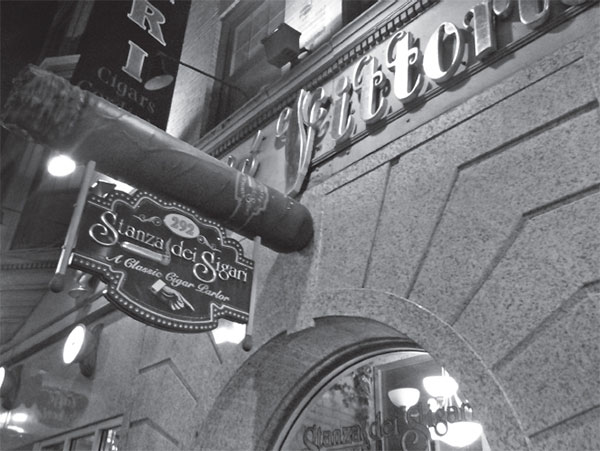
Stanza dei Sigari, an old-school cigar parlor on Hanover Street in Boston’s North End, was featured in the Syfy Channel’s Haunted Collector. Photo by Sam Baltrusis.
Riccio said his family-owned business has a history of paranormal activity. “I’ve always, even when I was a kid, thought there were ghosts down there,” he said.
The manager said employees witnessed plates flying off tables and lights turning on and off. A terrified waitress claimed that someone, or something, was standing behind her one night. When she turned around, she spotted a black shadow dart across the room and then escape through a glass door.
Brian J. Cano, an investigator with the now-defunct TV show Haunted Collector, wrote online that he was smitten with the location. “There is so much famous history in Boston and especially the North End, where our case was located. Honestly, I was surprised about the layout of this part of town,” Cano wrote on his behind-the-scenes blog. “I found it to be very European, with thin, winding side streets barely wide enough for a single car, bistros, bakeries and bike riders everywhere. The chain stores and restaurants I was used to seeing were nowhere to be found and that was strangely comforting. Corny as it sounds, I really could feel the echoes of the past reverberating off of [sic] every brick in the road, every tree that swayed in the wind.”
John Zaffis, the nephew of Ed and Lorraine Warren who specializes in removing any on-site trigger objects responsible for the location’s reported paranormal activity, led the Haunted Collector investigation with Cano at Stanza dei Sigari. His team’s findings were shocking.
The building was constructed in 1896, and the land had formerly been home to a “baby farm,” a Victorian-era underground business, which, in exchange for cash, took children from parents who were unable to care for them and sometimes killed them.
The sixty-year-old Riccio was born in the building located at 292 Hanover Street and heard various tales from his father and grandfather about the structure’s history, but he was shocked to learn about the sordid details involving children. “We were freaked out [that] it was a baby farm,” he told the Boston Herald.
The baby farm was owned and operated by a woman named Miss Elwood who had a history of abusing babies left at the baby farm. According to research uncovered by the TV show, she might have killed a few of the orphaned infants using arsenic. Zaffis and his Haunted Collector crew found a medical kit containing an 1870s-era syringe hidden within the building’s foundation.
Cano said the team spent days canvassing the location, ruling out other logical explanations for the paranormal phenomena, before team members stumbled on the nineteenth-century baby farm artifact. “At the café, we checked out the reports of cups and dishes flying off the shelves, the spinning wheel of the coffee grinder as well as the tommy gun encased above the back steps,” Cano wrote. “There was so much to see and so much to check off the list there.”
Once Zaffis removed the Victorian-era medical kit, the hauntings at Stanza dei Sigari reportedly stopped.
So what happened to the trigger objects confiscated by the Haunted Collector team? The crew’s lead investigator, Zaffis, recently purchased the former McBride Funeral Home in nearby Adams, Massachusetts, and plans to showcase the haunted artifacts—including the syringe confiscated from Stanza dei Sigari—at his Museum of the Paranormal.
“Over the course of years I’ve collected quite a few items,” the Connecticut-based Zaffis told the Berkshire Eagle. “They’re out in my barn now, but I always thought it would be fun to have people see the items and hear the stories about how they are connected to hauntings.”
Zaffis said the exhibit would operate on a rotating basis and would contain “a huge number of dolls from a number of cases, a haunted piano, haunted organ, statues, religious items, occult items, clothing, haunted books, a sewing machine, a haunted telephone, and a huge collection of haunted mirrors—they hold onto energy, they hold onto spirits.”
File under: trigger object